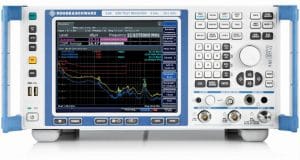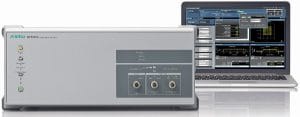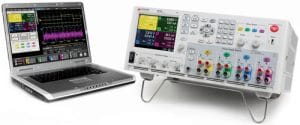 The advances in medical electronics as well as the increasing need for safe and accurate healthcare equipment have forced governing bodies to set up new quality standards for electro-medical devices. This article discusses the role of T&M equipment in ensuring these devices meet the stipulated quality standards.
The advances in medical electronics as well as the increasing need for safe and accurate healthcare equipment have forced governing bodies to set up new quality standards for electro-medical devices. This article discusses the role of T&M equipment in ensuring these devices meet the stipulated quality standards.
By Sneha Ambastha
The development and growth of modern medicine is quite dependent on electronics. There has been a sharp growth in technology based treatments and cures, the involvement of computers in diagnosis and the advent of high-end controllers. Almost all medical devices, ranging from a small pacemaker to a large MRI machine, have electronics within. Because of the critical functions these devices perform, it is very important that they are accurately tested and properly calibrated. T&M equipment take care of these priorities right at the design stage, and support the labs during maintenance and other services like repair and recalibration.
The role of T&M equipment
T&M equipment can work in two different ways—within the medical industry as an electro-medical device used to carry out medical tests at various levels, and as equipment used by design engineers/labs to enable the proper operation of these devices. In this article, our focus is on the second aspect.
Electro-medical devices have various electrical, environmental and operational requirements, depending on their function. The T&M devices assess and gauge these requirements, help the labs calibrate the instruments accordingly, and then allow their certification as per the quality standards. T.P. Singh, country head, FLIR Systems Pvt Ltd, informs, “Very basic instruments, ranging from humidity and temperature indicators to thermal imaging cameras, are being used in the medical electronics field. Parameters like voltage, current, frequency, temperature, humidity, particle count, pH value, sound level, light and time are required to be measured.” In the medical field, any defect in such measurements can result in an incorrect treatment.
The increasing use of wireless communication, mobile networks, TV, radio, complex PCB designs and the close proximity that various electrical devices operate in can lead to electromagnetic interference. This results in the electro-medical devices giving incorrect results or performing inaccurately. These devices are also susceptible to electromagnetic radiation in their working environments, which is why it is important that they comply with electromagnetic compatibility (EMC) standards, ensuring that they do not cause any interference to other electrical/electronic devices.
Rahul Gautam, electromagnetics compatibility group, Rohde & Schwarz, says, “EMC testing is one of the major quality and safety parameters. A medical device needs to comply with national and international EMC standards, as per government norms.” Then there are other important test conditions that need to be assessed like the compatibility of an electro-medical device when being used in direct contact with the human body or a particular organ, the short-term/long-term operation of the device in different working environments, the device’s ability to work continuously without/with interruptions, etc. For example, if a pacemaker inside the human body stops working when the body temperature increases beyond a certain level, then it would be useless. Thus, testing such devices beforehand becomes critical.
Proper testing and calibration of these electro-medical devices makes them eligible for export and import.
Factors affecting the development of T&M equipment
Says Gautam, “The government of India has recently published new medical device and in vitro diagnostic (IVD) regulations, which will go into effect on January 1, 2018. This will ease the norms for manufacturing medical devices and will promote domestic manufacturing. Presently, the medical devices market in India is worth around US$ 4 billion and 70 per cent of this constitutes imports. An increase in local production will increase the demand for T&M equipment, specially EMC testing equipment. We are expecting a lot of test houses to get established for medical device EMC testing, as the electro-medical device OEMs will be investing in such in-house facilities for early design-stage testing.”
Singh of FLIR Systems adds, “An increase in the requirement for accurate, reliable and cost effective electro-medical devices has increased the need for reliable T&M equipment. This will ensure that the medical devices do not interfere with other electronic devices in close proximity. There is also a growing need for medical devices to adhere to global regulations and standards.”
New market trends
Dipak Chavda, quality manager, Electronics and Quality Development Centre (EQDC), says, “T&M industries are now adopting a modular approach to portable testers, built-in self testing, automated test equipment and multi-functionality. T&M has also moved to the cloud.” It’s not just the test results or the measurement outputs that have shifted to the cloud, but various testing software can also be accessed on the cloud now.
Another important aspect is the growth of mechatronics in the medical industry. It’s been a few years now since its introduction, which has led to the miniaturisation and development of highly efficient electro-medical devices. This, in turn, has increased the demand for better and highly efficient T&M equipment. The term used to measure the ability of these devices to avoid errors and recover from them is ‘mechatronics maturity’. Verification and validation are the steps needed to minimise the errors caused by such systems.
Mechatronics involves the use of micro-actuators and micro-sensors in electro-medical devices, which reduces their size while improving their performance. This has increased the use of virtual test instruments/probes to test the signals generated by these micro-components. The use of these virtual test probes has certain benefits, which are listed below:
Negligible use of system resources
Less investment on hardware based test resources
Rapid and dynamic movement of virtual probes across the network
High operational efficiency due to their placement in virtual environments
What should buyers do?
The buyers of such T&M equipment are quality and test labs, the design houses, the manufacturers and the calibration labs for electro-medical devices. Singh says, “There are four major points that a buyer should keep a note of—accuracy, high performance and repeatability are the most critical parameters while selecting instruments; quality and brand image ensures reliability in this competitive market; immediate and on-time sales and services avoid any unnecessary expenses and delays; while the introduction of any advanced feature makes the devices future-ready and easy to use.”
This means that the T&M equipment should be as reliable as the electro-medical devices, and provide accurate readings and high performance. Branded and quality T&M equipment ensure reliability.
Chavda adds, “Range, accuracy, precision, calibration, unit of measurements, sensitivity, safety compliance as per national/ international norms, patient safety, operating conditions, communication protocols, size, etc, are some additional aspects to be noted.”
New products launched in this category
EMI test receiver with superior RF characteristics
 R&S ESW is an EMI test receiver from Rohde & Schwarz, capable of providing accurate measurement at a dynamic range. It meets the various requirements of international bodies like FCC, CISPR, MIL-STD-461, EN and DO-160, precisely. It has a real-time spectrum analysis capability that not only provides detailed analysis of the disturbance signal but also gives its history. The device is based on the Fast Fourier Transform (FFT) time domain scan, and can capture and measure the spectral disturbances in no time.
R&S ESW is an EMI test receiver from Rohde & Schwarz, capable of providing accurate measurement at a dynamic range. It meets the various requirements of international bodies like FCC, CISPR, MIL-STD-461, EN and DO-160, precisely. It has a real-time spectrum analysis capability that not only provides detailed analysis of the disturbance signal but also gives its history. The device is based on the Fast Fourier Transform (FFT) time domain scan, and can capture and measure the spectral disturbances in no time.
Wireless connectivity test sets to accelerate IoT testing
 Madhukar Tripathi, Anritsu India, says,”IoT or machine-to-machine (M2M) communication is a part and parcel of every industry today, including the medical industry, and this is the time for wireless communication. Be it a smart wearable, a glucometer, or any other electro-medical device, it is very important they communicate (wirelessly) effectively with their source to show the final measured output.”
Madhukar Tripathi, Anritsu India, says,”IoT or machine-to-machine (M2M) communication is a part and parcel of every industry today, including the medical industry, and this is the time for wireless communication. Be it a smart wearable, a glucometer, or any other electro-medical device, it is very important they communicate (wirelessly) effectively with their source to show the final measured output.”
Anritsu’s MT8862A is a wireless connectivity test set to measure the RF transceiver characteristics of WLAN IEEE802.11a/b/g/n/ac devices, and can accelerate the testing of IoT devices. It has built-in communication protocols that use the network mode to measure the performance of the target WLAN device under test in actual operating conditions. This network mode helps measure the RF performance characteristics and eliminates the requirement for any dedicated test modes provided by the vendor.
Battery drain analysis solutions
 N6781A, N6785A and N6705B are the power battery-drain analysis solutions from Keysight for critical energy based applications in the automotive and medical device industries. The power consumption of these devices has been increasing faster than their capability, resulting in a drop in battery runtime during critical operations. In the medical industry, in particular, such situations can lead to fatal errors. The requirement here is that the device manufacturers should maximise the battery life of such devices, particularly for the sensors and the monitors that work directly in connection with the human body. These battery drain analysis solutions help maximise the battery runtime and minimise the power failures of such critical devices.
N6781A, N6785A and N6705B are the power battery-drain analysis solutions from Keysight for critical energy based applications in the automotive and medical device industries. The power consumption of these devices has been increasing faster than their capability, resulting in a drop in battery runtime during critical operations. In the medical industry, in particular, such situations can lead to fatal errors. The requirement here is that the device manufacturers should maximise the battery life of such devices, particularly for the sensors and the monitors that work directly in connection with the human body. These battery drain analysis solutions help maximise the battery runtime and minimise the power failures of such critical devices.
What the future looks like
The increasing use of reliability and performance based T&M equipment in the medical industry has led to a greater need for the development of more T&M devices. “Nowadays, automation is used a lot more to reduce/remove human intervention in various manufacturing and service sectors, including the medical industry. Even surgeries are being done by robots,” says Chavda. High-end medical requirements are also generating the need for automated devices with compact footprints, forcing the designers to ask for better T&M devices.
To improve its services, the medical industry will increasingly rely on good quality T&M equipment that can help design devices with better and quicker results for effective screening, diagnosis, evaluating the severity of a disorder, planning treatment and monitoring the response to treatment.





























